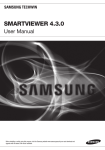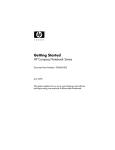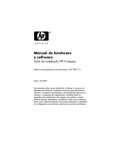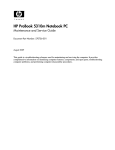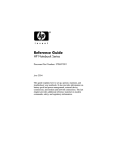Download HP L2000 Getting Started Guide
Transcript
Getting Started HP Notebook Series Document Part Number: 394138-001 June 2005 Enhanced for Accessibility. © Copyright 2005 Hewlett-Packard Development Company, L.P. Microsoft and Windows are U.S. registered trademarks of Microsoft Corporation. The information contained herein is subject to change without notice. The only warranties for HP products and services are set forth in the express warranty statements accompanying such products and services. Nothing herein should be construed as constituting an additional warranty. HP shall not be liable for technical or editorial errors or omissions contained herein. Getting Started HP Notebook Series First Edition June 2005 Document Part Number: 394138-001 Contents Next steps Install software . . . . . . . . . . . . . . . . . . . . . . Enable or disable TouchPad tapping. . . . . . . Protect your notebook . . . . . . . . . . . . . . . . . Protect your notebook from viruses . . . . . Protect your system files . . . . . . . . . . . . . Protect your privacy. . . . . . . . . . . . . . . . Protect your notebook from power surges . Use your notebook safely . . . . . . . . . . . . Turn off your notebook properly . . . . . . . Connect to the Internet . . . . . . . . . . . . . . . . Enable communication hardware . . . . . . Set up Internet service . . . . . . . . . . . . . . Update your software . . . . . . . . . . . . . . . . . Access your user guides . . . . . . . . . . . . . . . . . . . . . . . . . . . . . . . . . . . . . . . . . . . . . . . . . . . . . . . . . . . . . . . . . . . . . . . . . . . . . . . . . . . . . . . . . . . . . . . . . . . . . . . . . . . . . . . . . . . . . . . . . . . . . . . . . . . . . . . . . . . . . . . . . . . . . . . . . . . . . . . . . 1 . . . . . . 2 . . . . . . 3 . . . . . . 3 . . . . . . 4 . . . . . . 4 . . . . . . 5 . . . . . . 6 . . . . . . 7 . . . . . . 8 . . . . . . 8 . . . . . . 9 . . . . . 11 . . . . . 11 . . . . . . . . . . . . . . . . . . . . . . . . . . . . . . . . . . . . . . . . . . . . . . . . . . . . . . . . . . . . . . . . . . . . . . . . . . . . . . . . . . . . . . . . . . . . . . . . . . . Appendix A: Troubleshooting Before you begin . . . . . . . . . . . . . . . . Troubleshooting resources . . . . . . . Quick troubleshooting . . . . . . . . . . . . . Is the notebook unable to start up? . Is the notebook screen blank? . . . . . Is software functioning abnormally?. Is the notebook unresponsive?. . . . . Is the notebook overheating? . . . . . Is an external device not working? . Getting Started . . . . . . . . . . . . . . . . . . . . . . . . . . . . . . . . . . . . . . . . . . . . . . . . . . . . . . . . . . . . . . . A–1 A–1 A–2 A–2 A–3 A–4 A–5 A–6 A–6 iii Contents Help and Support Center . . . . . . . . . . . . . . . . . . . . . Customer Care . . . . . . . . . . . . . . . . . . . . . . . . . . . . Preparing to call Customer Care . . . . . . . . . . . . . Contacting Customer Care by e-mail or telephone . Taking the notebook to a service partner . . . . . . . Appendix B: . . . . . . . . . . . . . . . . . . . . . . . . . . . . . . . . . . . . . . . . A–7 A–8 A–8 A–9 A–9 . . . . . . . . . . . . . . . . . . . . . . . . ...... ...... ...... ...... ...... ...... ...... ...... ...... ...... ...... ...... B–1 B–2 B–2 B–3 B–3 B–4 B–4 B–5 B–6 B–7 B–8 B–8 System recovery Safeguarding your data . . . . . . . . . . . . . . . . . . Using System Restore . . . . . . . . . . . . . . . . . . . . Setting a restore point . . . . . . . . . . . . . . . . . Restoring to a restore point . . . . . . . . . . . . . . Repairing or reinstalling applications . . . . . . . . . Reinstalling applications from your hard drive . Reinstalling applications from discs . . . . . . . . Repairing the operating system. . . . . . . . . . . . . . Reinstalling the operating system . . . . . . . . . . . . Reinstalling device drivers and other software . . . Updating reinstalled software . . . . . . . . . . . . . . . Installing a retail version of an operating system . . . . . . . . . . . . . . . . . . . . . . . . . . . . . . . . . . . . . . Index iv Getting Started Next steps Install software Software on optical discs (CDs and DVDs) is included with your notebook: ■ The discs packaged in the “Required for Setup” bag provide software that is not preinstalled on your notebook. Depending on how you plan to use your notebook, you may want to install some or all of these applications. You can install this software at any time. ■ The discs packaged in a second bag are the recovery discs for software that is preinstalled or preloaded on your notebook. The recovery discs are provided in case you need to repair or reinstall preinstalled or preloaded software. ❏ Operating system recovery and driver recovery software is included with all notebook models. ❏ Application recovery software is provided with select models. information about accessing additional product documentation, refer ✎ For to “Access your user guides,” later in this chapter. Getting Started 1 Next steps Enable or disable TouchPad tapping Tapping is a TouchPad preference that enables you to tap the TouchPad once to select an item or twice to double-click an item. This feature is enabled by default. To disable or reenable TouchPad Tapping: 1. Use the TouchPad to select Start > Control Panel > Printers and Other Hardware > Mouse > Device Settings. Then select Settings. 2. Select Tapping. If the Enable Tapping check box is selected, TouchPad Tapping is enabled. ❏ To disable TouchPad Tapping, clear the check box. ❏ To enable TouchPad Tapping, select the check box. 3. Select OK. Windows instructions in your user guides describe Microsoft® ✎ All Windows® XP procedures based on the default Windows XP category view. To switch between category view and classic view within Control Panel: » Select your preference in the Control Panel pane in the left panel of the Control Panel window. To get more information about Windows XP category view and Windows XP classic view: » Select Start > Help and Support > Customizing your computer > Files, folders, and programs > Use Windows classic folders. 2 Getting Started Next steps Protect your notebook You can use the information in this section to ■ Protect your notebook from viruses. ■ Protect your system files. ■ Protect your privacy. ■ Protect your notebook from power surges. ■ Use your notebook safely. ■ Turn off your notebook properly. Protect your notebook from viruses When you use your notebook for e-mail, network, or Internet access, you expose the notebook to computer viruses. Computer viruses can disable your operating system, applications, or utilities, or cause them to function abnormally. Antivirus software can detect most viruses, destroy them, and, in most cases, repair damage they have caused. To provide ongoing protection against newly discovered viruses, antivirus software must be updated. Norton AntiVirus software is preinstalled on your notebook: ■ Your version of Norton AntiVirus software includes 60 days of free updates. It is strongly recommended that you protect your notebook against new viruses beyond 60 days by purchasing extended update service. ■ Instructions for using and updating your Norton AntiVirus software and for purchasing extended update service are provided within the application. ■ To access your Norton AntiVirus software, select Start > All Programs > Norton Internet Security. Getting Started 3 Next steps Protect your system files System Restore is an operating system feature that enables you to undo harmful changes to your notebook software by restoring your software to an earlier time, called a restore point, when your software was functioning optimally. Manually setting additional restore points provides additional protection for your system files and settings. It is recommended that you manually set restore points ■ Before you add or extensively modify software or hardware. ■ Periodically, whenever the system is performing optimally. For more information about setting, and restoring from, restore points, refer to “Using System Restore” in Appendix B, “System recovery.” Protect your privacy When you use your notebook for e-mail, network, or Internet access, it is possible for unauthorized persons to obtain information about your notebook and your data. To optimize the privacy protection features included with your notebook, it is recommended that you ■ Keep your operating system updated. Many Windows updates contain security enhancements. For information about updating your operating system, refer to “Update your software,” later in this chapter, and also to “Updating reinstalled software” in Appendix B, “System recovery.” ■ Use a firewall. A firewall is software that monitors incoming traffic on your notebook. Some firewalls also monitor outgoing traffic. 4 Getting Started Next steps Protect your notebook from power surges To protect your notebook from the power surges that may be caused by an uncertain power supply or an electrical storm: ■ Plug the notebook power cord into an optional, high-quality surge protector. Surge protectors are available from most computer or electronics retailers. ■ During an electrical storm, either run the notebook on battery power or shut down the notebook and unplug the power cord. ■ If applicable to your location, provide surge protection on the cable that connects the modem to a telephone line. Telephone line surge protectors are available from computer or electronics retailers in some regions. Getting Started 5 Next steps Use your notebook safely Å■ WARNING: To reduce the risk of electric shock or damage to your equipment: Plug the power cord into an AC outlet that is easily accessible at all times. ■ Disconnect power from the notebook by unplugging the power cord from the AC outlet (not by unplugging the power cord from the notebook). ■ If provided with a 3-pin attachment plug on your power cord, plug the cord into a grounded (earthed) 3-pin outlet. Do not disable the power cord grounding pin; for example, by attaching a 2-pin adapter. The grounding pin is an important safety feature. Å WARNING: To reduce the risk of serious injury, read the Safety and Comfort Guide. It describes proper workstation setup, and proper posture, health, and work habits for notebook users. The Safety and Comfort Guide also provides important electrical and mechanical safety information. This guide is available on the Web at http://www.hp.com/ergo and through the Help and Support Center at Start > Help and Support > User Guides. Å WARNING: To avoid potential discomfort or burns, do not block the air vents or use the notebook on your lap for extended periods. The notebook is designed to run demanding applications at full power. As a result of increased power consumption, it is normal for the notebook to feel warm or hot when used continuously. The notebook complies with the user-accessible surface temperature limits defined by the International Standard for Safety of Information Technology Equipment (IEC 60950). For more safety and regulatory information, refer to Regulatory and Safety Notices by selecting Start > Help and Support > User Guides. 6 Getting Started Next steps Turn off your notebook properly Whenever possible, turn off the notebook by using the standard Windows shutdown procedure for your operating system: ■ In Windows XP Home, select Start > Turn Off Computer > Turn Off. ■ In Windows XP Professional, select Start > Turn Off Computer > Shut Down > OK. (If you connect your notebook to a network domain, the name of the Turn Off Computer button may change to Shut Down.) If the notebook does not respond, try the following shutdown procedures: ■ Press ctrl+alt+delete. Then ❏ If the notebook is running Windows XP Home, select Shut Down > Turn Off. ❏ If the notebook is running Windows XP Professional, select Shut Down from the drop-down list, and then select OK. ■ If the notebook does not respond to the ctrl+alt+delete procedure, press and hold the power button for 5 seconds. Getting Started 7 Next steps Connect to the Internet To connect the notebook to the Internet, you must enable your communication hardware and have an account with an Internet service provider (ISP). Enable communication hardware Your modem is enabled when the modem cable is connected to the notebook and to an analog telephone line. ■ If you have already connected your modem cable, your modem is enabled. Proceed to “Set up Internet service,” next in this chapter. ■ To connect your modem cable: a. Turn off your notebook. b. Place your notebook display-side up on a flat surface near a telephone wall jack. c. If your modem cable has noise suppression circuitry, which prevents interference with TV and radio reception, orient the circuitry end of the cable toward the notebook. suppression circuitry is contained in a small cylinder near one ✎ Noise end of the modem cable. d. Plug the modem cable into the RJ-11 (modem) jack on the notebook. e. Plug the other end of the modem cable into the telephone wall jack. f. Turn on your notebook in Windows. g. Proceed to “Set up Internet service,” next in this chapter. For more information about LAN, cable, or DSL Internet connections, select Start > Help and Support. The Help and Support utility provides hardware and software information, instructions, tutorials, and wizards that can help you set up or troubleshoot a variety of connections. 8 Getting Started Next steps Set up Internet service You must set up Internet service before you can connect to the Internet. Your notebook includes software developed with leading ISPs in many locations to help you set up a new Internet account or configure your notebook to use an existing account. Depending on your location, you may be able to set up Internet service by using the Easy Internet Sign-up utility or an ISP-provided icon on your desktop. In all locations, you can set up Internet service by using the Windows Internet Connection Wizard. Using Easy Internet Sign-Up If the Easy Internet Sign-up utility is supported in the country in which you purchased your notebook, you can access the utility by using either of the following methods: ■ Double-click the Easy Internet Sign-up icon on the Windows desktop. – or – ■ Select Start > All Programs > Online Services > Easy Internet Sign-up. The Easy Internet Sign-up utility enables you to ■ Sign up for a new Internet account. ■ Configure your notebook to use an existing account. ■ Learn about accessing the Internet through a LAN (local area network), cable, or DSL connection. If you plan to use a LAN, cable, or DSL Internet connection, you may need to contact your ISP for information about obtaining additional software or hardware. For more information about LAN, DSL, or cable Internet connections, select Start > Help and Support. If the Easy Internet Sign-up utility is not available on your notebook, refer to “Using an ISP-provided icon,” next in this chapter. Getting Started 9 Next steps Using an ISP-provided icon If ISP-provided icons are supported in the country in which you purchased your notebook, the icons may be displayed either individually on the Windows desktop or grouped in a desktop folder named Online Services. To set up a new Internet account or configure your notebook to use an existing account: » Double-click an icon, and then follow the instructions on the screen. Using the Internet Connection Wizard You can use the Windows Internet Connection Wizard to connect to the Internet ■ If you already have an account with an ISP. ■ If you have a disc from an ISP. ■ If you do not have an Internet account and would like to select an ISP from the list provided within the wizard. (The list of ISP providers is not available in all regions.) ■ If you have selected an unlisted ISP and the ISP has provided you with such information as a specific IP address, and POP3 and SMTP settings. To access the Internet Connection Wizard and instructions for using the wizard: » Select Start > Help and Support. If you are prompted within the wizard to choose between enabling or disabling Windows Firewall, it is recommended that you choose to enable the firewall. For more information about firewalls, refer to “Protect your privacy,” earlier in this chapter. 10 Getting Started Next steps Update your software Most software, including the operating system, is updated frequently by the manufacturer or provider. Important updates to the software included with your notebook may have been released since the notebook left the factory. Some updates may affect the way your notebook responds to optional software or external devices. Many updates provide security enhancements. It is strongly recommended that you update the operating system and other software provided on your notebook as soon as the notebook is connected to the Internet. To access update links for the operating system and other software provided on your notebook: » Select Start > Help and Support. Access your user guides User guides, reference manuals, regulatory and safety notices, and other resources that provide information about using your notebook are available through the Help and Support Center. To access documents in the Help and Support Center: » Select Start > Help and Support > User Guides. For more information about the resources available through the Help and Support Center, refer to “Help and Support Center” in Appendix A, “Troubleshooting.” ✎ A User Guides disc is included with select notebook models. Getting Started 11 A Troubleshooting Before you begin Troubleshooting resources If you experience problems with your notebook, try the following suggestions in the order listed below and presented in this appendix: ■ Refer to “Quick troubleshooting,” next in this chapter. ■ Access the Help and Support Center for additional information about your notebook. Select Start > Help and Support. many checkup and repair features require an Internet ✎ Although connection, many other features can help you fix a problem while the notebook is offline. ■ Visit the technical support Web site at http://www.hp.com/support for answers to common questions. ■ Contact Customer Care for further assistance. Getting Started A–1 Troubleshooting Quick troubleshooting Is the notebook unable to start up? To turn on the notebook, press the power button. When the notebook is turned on, the power/standby light is turned on. If the notebook and the power/standby light are not turned on when you press the power button, adequate power may not be available to the notebook. ■ If the notebook is running on battery power or is connected to an external power source other than an AC outlet, connect the notebook to an AC outlet using the AC adapter. Make sure the power cord and AC adapter connections are secure. ■ Verify that the AC outlet is providing adequate power by plugging another electrical device into the outlet. the notebook can be turned on when connected to external power but ✎ Ifcannot be turned on when running on a battery pack, recharge the battery pack. A–2 Getting Started Troubleshooting Is the notebook screen blank? If you have not turned off the notebook but the screen is blank, the notebook may be in standby or hibernation, or may not be set to display the image on the notebook screen. ■ To resume from standby or restore from hibernation, briefly press the power button. Standby and hibernation are energy-saving features that can be initiated by the system while the notebook is in Windows but is not in use. ❏ When standby is initiated, the power/standby light blinks, your work is saved in random access memory (RAM), and the screen clears. ❏ When hibernation is initiated, your work is saved to a hibernation file on the hard drive, the notebook shuts down, and the power/standby light is turned off. ■ To switch the image to the notebook screen, press fn+f4. ❏ On most notebook models, when an optional external display device, such as a monitor, is connected to the notebook, the image can be displayed at any time on the notebook screen, the external display device, or on both the notebook screen and the external display device simultaneously. When you press fn+f4, the image is switched among the notebook, one or more external display devices, and simultaneous display. ❏ On some notebook models, the function of fn+f4 is determined by the software you are using. Getting Started A–3 Troubleshooting Is software functioning abnormally? If your software becomes unresponsive or responds abnormally: ■ Restart the notebook: ❏ In Windows XP Home, select Start > Turn Off Computer > Restart. ❏ In Windows XP Professional, select Start > Turn Off Computer > Restart > OK. (The Turn Off Computer button may be called the Shut Down button, depending on your network connections). If you cannot restart the notebook using these procedures, refer to the next section, “Is the notebook unresponsive?” ■ Run a virus scan. For information about using the antivirus resources on your notebook, refer to “Protect your notebook from viruses” in the “Next steps” chapter. ■ If the notebook feels extremely warm, allow it to cool to room temperature. For more information about notebook overheating, refer to “Is the notebook overheating?” later in this appendix. ■ If you are using an optional cordless mouse, make sure that the mouse battery is adequately charged and that the cordless mouse is not causing interference. A–4 Getting Started Troubleshooting Is the notebook unresponsive? If the notebook has stopped responding, try first to shut down the notebook using the shutdown procedure for your operating system. ■ In Windows XP Home, select Start > Turn Off Computer > Turn Off. ■ In Windows XP Professional, select Start > Turn Off Computer > Shut Down > OK. (The Turn Off Computer button may be called the Shut Down button, depending on your network connections.) If the notebook remains unresponsive, try the following emergency shutdown procedures in the sequence provided: ■ If the notebook is in Windows, press ctrl+alt+delete. Then ❏ If the notebook is running Windows XP Home, select Shut Down > Turn Off. ❏ If the notebook is running Windows XP Professional, select Shut Down from the drop-down list, and then select OK. ■ If you cannot shut down the notebook by using ctrl+alt+del, press and hold the power button for at least 5 seconds. ■ If you are unable to shut down the notebook by using the power button, disconnect the notebook from external power and remove the battery pack. Getting Started A–5 Troubleshooting Is the notebook overheating? It is normal for the notebook to feel warm to the touch while it is in use. But if the notebook feels extremely warm, it may be overheating because a vent is blocked. If you suspect that overheating could be causing the problem, allow the notebook to cool to room temperature. Then be sure to keep all vents free from obstructions while you are using the notebook. Is an external device not working? If an external device does not function as expected: ■ Turn on the device as instructed in the device documentation. Some devices, such as monitors and printers, must be turned on before the notebook is turned on. ■ Verify that ❏ All device connections are secure. ❏ The device is receiving electrical power. ❏ The device, especially if it is an older device, is compatible with your operating system. For compatibility information, select Start > Help and Support, or visit the Web site of the device manufacturer or provider. ❏ The correct drivers are installed and updated. Drivers may be available on a CD included with the device or on the Web site of the device manufacturer or provider. For more information about updating drivers, select Start > Help and Support. A–6 Getting Started Troubleshooting Help and Support Center To access the Help and Support Center, select Start > Help and Support. In addition to providing information about your operating system, the Help and Support Center provides ■ Information about your notebook, such as model and serial number, installed software, hardware components, and specifications. ■ Answers to questions about using your notebook. ■ Tutorials, user guides, and reference manuals to help you learn to use notebook and operating system features. ■ Updates for your operating system, device drivers, and the software provided on your notebook. ■ Checkups for notebook functionality. ■ Automated and interactive troubleshooting, repair solutions, and system recovery procedures. ■ Links to Customer Care specialists. ■ Links to community forums of IT experts. Getting Started A–7 Troubleshooting Customer Care If you are unable to find the help you need by using the Help and Support Center at Start > Help and Support, you may need to contact Customer Care. Preparing to call Customer Care For the fastest possible resolution of your problem, have the notebook and the following information available when you call or e-mail: ■ Serial number (S/N) and product number (P/N), which are provided on the Service Tag. ❏ The Service Tag label is affixed to all notebook models, usually on the bottom of the notebook. ❏ To display the Service Tag information on the notebook screen, select Start > Help and Support > My Compaq Computer. ■ Purchase date on the invoice. ■ Conditions under which the problem occurred. ■ Error messages that have been displayed. ■ The manufacturer and model of a printer connected to the notebook. ■ Operating system version number and registration number. To display the operating system version number and registration number, select Start > Help and Support > My Compaq Computer. (On some notebook models, the registration number may be identified in the Operating System table as the Product Id). A–8 Getting Started Troubleshooting Contacting Customer Care by e-mail or telephone If the notebook is connected to the Internet, select Start > Help and Support to get help by e-mail or to access Customer Care telephone numbers. If the notebook is not connected to the Internet, refer to the printed warranty or Worldwide Telephone Numbers booklet (English only) included with the notebook to contact Customer Care. Taking the notebook to a service partner If Customer Care advises you to take your notebook to a service partner, be sure to provide the service partner with the information listed in “Preparing to call Customer Care,” earlier in this appendix. In addition, be sure to delete all passwords or to disclose all passwords to the service partner. For information about deleting a Microsoft Windows password, select Start > Help and Support. (The deletion procedures vary according to the types of Windows passwords you have set.) Getting Started A–9 B System recovery To recover system functionality, you can use the System Restore utility or the recovery discs included with your notebook. Recovering functionality through System Restore preserves all of your personal data and settings and is a reversible procedure. Repairing device drivers and applications by using Driver Recovery or Application Recovery discs also preserves your personal data and settings. If you use the Operating System disc to ■ Repair your operating system, your data and settings are preserved. ■ Reinstall your operating system, your data, settings, and installed software are deleted. best results, attempt to recover optimal notebook functionality by ✎ For following the procedures in this appendix in the order provided. Safeguarding your data Software or devices added to the notebook can cause your system to become unstable. To safeguard your documents, store your personal files in the My Documents folder and periodically create a backup copy of My Documents. Getting Started B–1 System recovery Using System Restore System Restore is an operating system feature that enables you to undo harmful changes to your notebook software by restoring your software to an earlier time, called a restore point, when your software was functioning optimally. Restore points are restorable, benchmark “snapshots” of your software, driver, and operating system files. The notebook sets restore points at regular intervals and may set additional restore points whenever you change your personal settings or add software or hardware. Manually setting additional restore points provides additional protection for your system files and settings. It is recommended that you manually set restore points ■ Before you add or extensively modify software or hardware. ■ Periodically, whenever the system is performing optimally. Restoring to any restore point does not affect your data files. For example, restoring your system software to an earlier time will not affect documents or e-mails that you saved after that time. All System Restore procedures are reversible. Setting a restore point To set a system restore point manually: 1. Select Start > Help and Support > System Restore. 2. Select Create a restore point, and then follow the instructions on the screen. B–2 Getting Started System recovery Restoring to a restore point To restore the notebook to a restore point: 1. Make sure the notebook is connected to a reliable AC outlet through the AC adapter. 2. Select Start > Help and Support > System Restore. 3. Select Restore my computer to an earlier time, and then follow the instructions on the screen. Repairing or reinstalling applications All applications preinstalled or preloaded on your notebook can be repaired or reinstalled by using the application recovery software included with your notebook. The location of this software varies by notebook model, but is usually provided on a Driver Recovery or an Application Recovery disc. you have not reinstalled your operating system, some applications ✎ Ifpreloaded on your notebook, such as those available in the Software Setup utility, can also be repaired or reinstalled from your hard drive. The application reinstallation process repairs or replaces corrupted system files within the application and reinstalls deleted system files within the application. ■ In most cases: If the application you are repairing or reinstalling is still installed on your notebook, the reinstallation process does not affect your settings within the application. ■ In all cases: If an application has been deleted from your notebook, the reinstallation process reinstalls the application or utility in its original form, which replaces your settings with factory default settings. Getting Started B–3 System recovery Reinstalling applications from your hard drive To reinstall a preloaded application or utility from your hard drive: » Select Start > All Programs > Software Setup, and then follow the instructions on the screen. (When you are prompted to select the software you want to reinstall, you can select or clear the check boxes for some or all of the listed items.) Reinstalling applications from discs To reinstall an application from a recovery disc: » While the notebook is in Windows, insert the disc into the optical drive, and then follow the instructions on the screen. (When you are prompted to select the applications you want to reinstall, you can select or clear the check boxes for some or all of the listed items.) If the disc does not open within several seconds: a. Select Start > Run. b. In the Open text field, type D:\SWSETUP\APPINSTL\SETUP.EXE where D indicates the optical drive. c. Select OK. B–4 Getting Started System recovery Repairing the operating system An operating system repair does not delete your personal data. To repair the operating system, use the Operating System disc that was shipped with the notebook: 1. Connect the notebook to an AC outlet through the AC adapter, and then turn on the notebook. 2. Immediately insert the Operating System disc into the notebook. 3. Shut down the notebook using the standard shutdown procedure for your operating system. you are unable to shut down the notebook using the operating ✎ Ifsystem, press and hold the power button for 5 seconds. (If your notebook has a power/standby button, a power switch, or a power/standby switch instead of a power button, refer to “Quick troubleshooting” in Appendix A, “Troubleshooting.”) 4. Turn the notebook on by briefly pressing the power button. 5. When prompted, press any key to boot from the disc. (After a few minutes, the setup wizard opens and the “Welcome to Setup” page is displayed.) On the “Welcome to Setup” page do not press R (step 8 in this ✎ procedure) until you have completed steps 6 and 7. 6. Press enter to continue. (A Licensing Agreement page is displayed.) 7. Press f8 to accept the agreement and continue. (The “Setup” page is displayed.) 8. Press R to repair the selected Windows installation. (The repair process begins.) This process may take up to 2 hours to complete. The notebook restarts in Windows after the process is complete. Getting Started B–5 System recovery Reinstalling the operating system Ä CAUTION: To prevent the loss of all of your personal data, back up your data before reinstalling the operating system. Personal data and any software you have installed on the notebook will be lost during the operating system reinstallation process. the reinstallation, you may be prompted for your Product Key. Your ✎ During Product Key is provided on the Microsoft Certificate of Authenticity label affixed to your notebook. On most notebook models, this label is affixed to the bottom of the notebook. If other recovery efforts do not successfully repair the operating system, you can reinstall it. To reinstall the operating system: 1. Connect the notebook to an AC outlet through the AC adapter, and then turn on the notebook. 2. Immediately insert the Operating System disc into the notebook. 3. Shut down the notebook using the standard shutdown procedure for your operating system. you are unable to shut down the notebook using the operating ✎ Ifsystem, press and hold the power button for 5 seconds. (If your notebook has a power/standby button, a power switch, or a power/standby switch instead of a power button, refer to “Quick troubleshooting” in Appendix A, “Troubleshooting.”) 4. Turn the notebook on by briefly pressing the power button. 5. When prompted, press any key to boot from the disc. (After a few minutes, the setup wizard opens and the “Welcome to Setup” page is displayed.) 6. Press enter to continue. (A Licensing Agreement page is displayed.) 7. Press f8 to accept the agreement and continue. (The “Setup” page is displayed.) B–6 Getting Started System recovery 8. Press esc to continue installing a new copy of the operating system instead of repairing it. 9. Press enter to set up the operating system. 10.Press C to continue setup using this partition. 11.Select Format the partition using the NTFS file system (Quick), and then press enter. Ä Formatting a drive deletes all current files. 12.Press F to format the drive. (The reinstallation process begins.) This process takes 1 to 2 hours to complete. The notebook restarts in Windows when the process is complete. Reinstalling device drivers and other software After the operating system installation process is complete, you must reinstall drivers. To reinstall drivers, use the Driver Recovery disc included with the notebook: » While the notebook is in Windows, insert the disc into the optical drive, and then follow the instructions on the screen. (When you are prompted to select the applications you want to reinstall, you can select or clear the check boxes for some or all of the listed items.) If the disc does not open within several seconds: a. Select Start > Run. b. In the Open text field, type D:\SWSETUP\APPINSTL\SETUP.EXE where D indicates the optical drive. c. Select OK. After the drivers are reinstalled, you can reinstall any software you added to the notebook. Follow the installation instructions provided with the software. Getting Started B–7 System recovery Updating reinstalled software It is strongly recommended that you update all reinstalled software. Depending on the settings you used on your former configuration, some software may have been updated without your knowledge. Use the following update procedures as soon as your notebook is connected to the Internet. ■ To update your operating system and the software included on your notebook, select Start > Help and Support. ■ To update software that was not provided on your notebook, follow the instructions included with the software. Many applications include an update feature that you can access from a Help button or menu item within the application. Installing a retail version of an operating system Ä CAUTION: To prevent the loss of notebook operating system enhancements, do not install a retail version of an operating system. In some cases, the loss of enhancements may result in an unresponsive system. The operating system that was shipped on your notebook and on the Operating System disc included with your notebook is enhanced for HP notebooks. The enhancements add power and security features and provide supplementary support for external devices such as drives and PC Cards. The functionality of your notebook was tested for use with the operating system provided with your notebook. B–8 Getting Started Index A D AC adapter troubleshooting A–2 using during software reinstallation or repair B–3, B–5 antivirus software 3, A–4 Application Recovery disc 1 applications. See software devices, external drivers 1, A–6 troubleshooting A–6 diagnostic features A–7 discs included with notebook 1 ISP 10 recovery 1, B–1 User Guides 11 display, switching image A–3 documentation 11 Driver Recovery disc 1 drivers obtaining 1, A–6 reinstalling or repairing 1, B–7 DSL connections 8 DVDs. See discs B backup B–1 buttons power 7, A–5 C cables and cords modem 5, 8 power 5, A–2 category view, Windows XP 2 CDs. See discs Certificate of Authenticity, Microsoft B–6 classic view, Windows XP 2 computer viruses 3, A–4 cord, power 6, A–2 customer support Help and Support Center A–7 service partners A–9 user guides 11 E Easy Internet Sign-up 9 electrical storm, precautions and procedures 5 external devices drivers 1, A–6 troubleshooting A–6 F firewalls 4, 10 Getting Started Index–1 Index G O guides, user 11 Online Services folder 10 operating system displaying version number A–8 finding tours and tutorials A–7 Help and Support Center A–7 installing retail version B–8 Internet Connection Wizard 10 reinstalling B–1, B–6 repairing B–1, B–5 System Restore 4, B–2 updating 11, B–8 Operating System disc 1 overheating, notebook 6, A–6 H hard drive hibernation file A–3 preloaded software 1, B–4 Help and Support Center 11, A–7 See also customer support hibernation A–3 I IEC 60950 compliance 6 image, switching among display devices A–3 Internet connection enabling hardware 8 setting up Internet service 9 Internet Connection Wizard 10 ISP service, setting up 9 L labels Microsoft Certificate of Authenticity B–6 Service Tag A–8 lockup, system A–5 M Microsoft Certificate of Authenticity B–6 model number, notebook A–7 modem connecting 8 setting up Internet service 9 surge protection 5 virus protection 3 monitor, external A–3, A–6 N network connections 8 Norton AntiVirus 3, A–4 Index–2 P power problems, troubleshooting A–2 surge protection 5 turning off notebook 7 turning on notebook A–2 power button emergency shutdown A–5 turning off notebook 7 power cord 2-pin adapter 6 surge protection 5 power/standby lights blinking A–3 on, off A–2, A–3 printer A–6 privacy protection features 4 Product Id A–8 Product Key B–6 product number, notebook A–8 R RAM A–3 recovery discs 1, B–1 recovery, system B–1 Getting Started Index reference guides 11 registration number, operating system A–8 Regulatory and Safety Notices 6 regulatory information 6 reinstalling or repairing software procedures B–1 recovery discs 1, B–1 System Restore 4, B–2 reset (emergency shutdown) A–5 restore point 4, B–2 S Safety and Comfort Guide 6 serial number, notebook A–7, A–8 service partners A–9 See also customer support Service Tag A–8 shutting down notebook 7, A–5 software Easy Internet Sign-up 9 firewall 4, 10 Help and Support Center A–7 Internet Connection Wizard 10 Norton AntiVirus 3 reinstalling or repairing 1, B–1 System Restore 4, B–2 specifications, notebook A–7 standby A–3 surge protection 5 system lock-up A–5 system recovery B–1 System Restore 4, B–2 system restore points B–2 temperature safety considerations 6 troubleshooting A–6 tours, tutorials A–7 troubleshooting procedures display problems A–3 external device problems A–6 hibernation or standby problems A–3 overheating problems A–6 response problems A–5 software problems A–4 virus problems A–4 troubleshooting resources Help and Support Center A–7 service partners A–9 user guides 11 See also troubleshooting procedures turning off notebook 7, A–5 turning on notebook A–2 tutorials, tours A–7 U updates, software B–8 user guides 11 User Guides disc 11 V vents A–6 viruses, computer 3, A–4 W Windows category vs. classic view 2 Windows firewall 4 Worldwide Telephone Numbers A–9 T technical support Help and Support Center A–7 service partners A–9 user guides 11 Getting Started Index–3




































